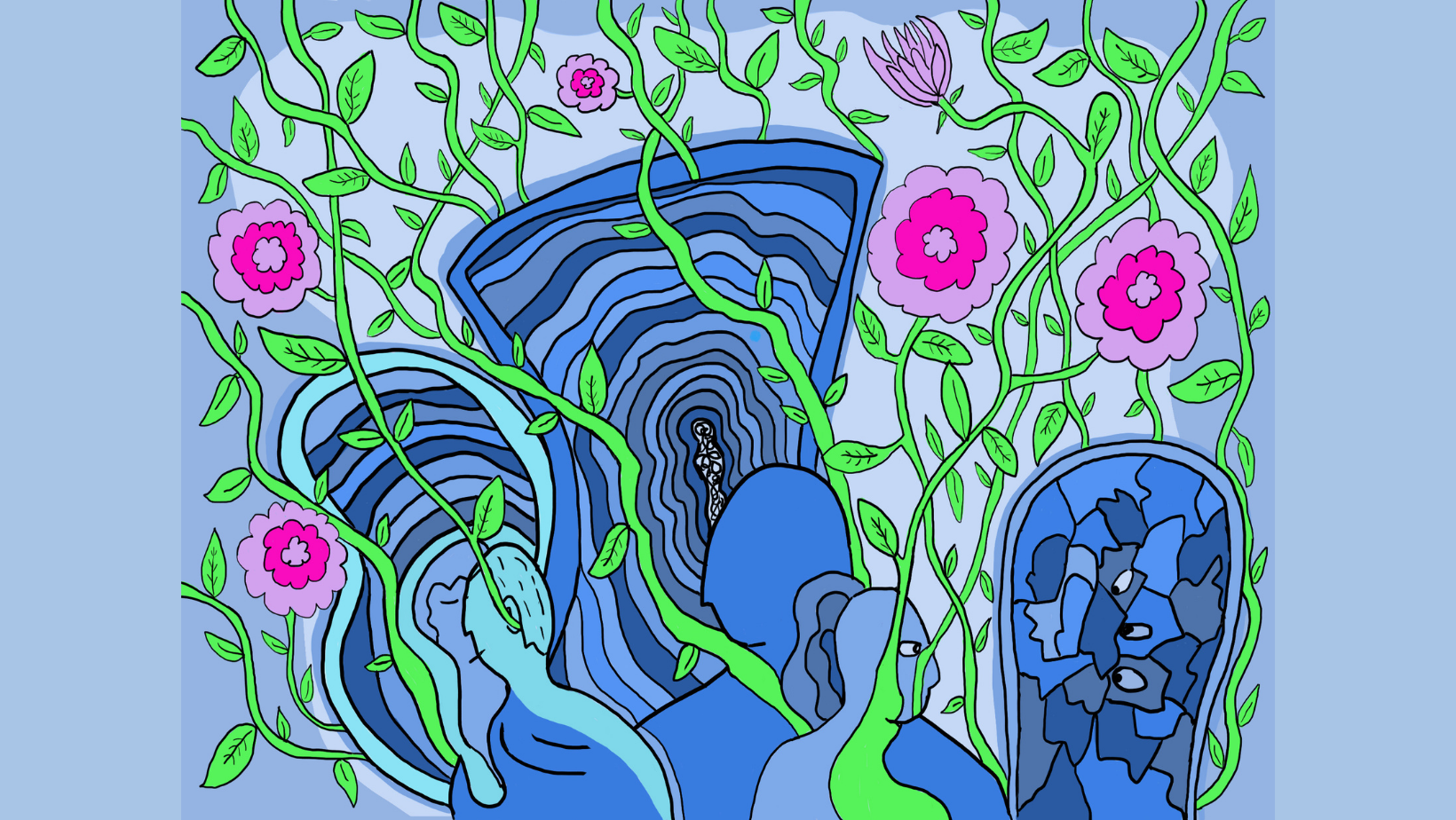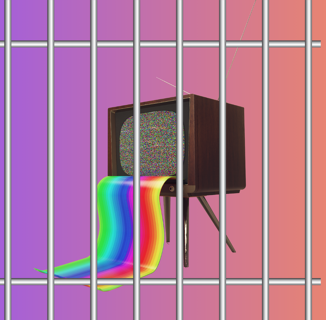CW// Eating Disorders, Body Dysmorphia.
Growing up in the 90s, there were a lot of books seemingly aimed at me, about my health.
From “The Body Project” and “Reviving Ophelia” to the seminal “The Beauty Myth,” bookstore shelves were crowded with stories of body image dysmorphia and the skewed version women were forced to have of themselves.
As someone who grew up as the target audience for these books, I felt their importance while assuming they had nothing to do with me. I was not a woman, and not a girl, though that would not be apparent to anyone else for years. I had always been trans, and had always known it. But I was also a person who had to encounter puberty, female socialization, and all the coded, destructive language about bodies that goes with it. I knew that on some level, I would never be happy with my body.
When the culture started to take eating disorders seriously, it coincided with my adolescence. At that time, the deep focus on a singular group—cisgender, post-adolescent, white, middle-class women—was at the cost of largely ignored experiences of marginalized women, women and girls of color, men of all races, and folks across the gender spectrum. It made sense in the moment: The women writing about their experiences fit this profile could ultimately afford the pricey treatments that the variants of this disease cost them. They could afford rehab and hospital care. A lot of us couldn’t. And even when we could, it was complicated.
I have always been trans. But I also had to encounter puberty, female socialization, and all the coded, destructive language about bodies that goes with it.
While trans men and nonbinary folks struggle against being perceived as female or gendered, we’re also, on some level, taking in those messages about our worth and meaning. As trans guys, we’re doing all we can, from the moment we’re born, to achieve the kind of body we could actually live with. But whether we decide to achieve this by taking testosterone, going to the gym each day, using steroids, or starving ourselves, we’re likely to fall into the same trap that was created for teenaged cis girls. Your body isn’t good enough, society says, and it never will be.
The classic representation of the anorexia nervosa victim hasn’t changed much from those classic portrayals of young women in the 19th century dying of consumption. Victims are seen as white, fragile, and too pure for this world. Even though Black cis women are 50% more likely to show signs of disordered eating during their teen years than their white cis counterparts, we still favor only one narrative. Marginalized groups with high depression rates and a lack of funds make up a large percentage of sufferers, and marginalized communities have less recourse to inpatient treatment.
According to the National Association of Anorexia Nervosa and Associated Disorders, 13% of cis women over 50 suffer from disordered eating. In this country alone, 30 million people of all genders have dealt with disordered eating at some point. Queer people are just starting to figure into the research. Eating disorders are one of the deadliest mental illnesses on record in this country, beating out even clinical depression for mortality rates. If we know that around 20% of patients affected die of the disease, and we know trans folks, older cis women, folks of color, and cis men are part of that statistic. 16% of transgender folks of college age report dealing with some form of ED. Puzzlingly, when it comes to adult trans folks, and especially adult trans men, there’s not a lot of data on record.
Allegra Gordon, a research scientist at the Division of Adolescent/Young Adult Medicine, Boston Children’s Hospital and an Instructor in the Department of Pediatrics at Harvard Medical School, has been researching LGBTQ+ communities dealing with stigma in medical environments for the past 15+ years.
When it comes to adult trans folks, and especially adult trans men, there’s not a lot of data on record.
“I became more involved in research on eating disorders prevention when I noticed that in public health and medicine there was a real lack of attention to eating disorders and body image concerns in LGBTQ and other marginalized populations and some huge gaps in our research knowledge, especially for transgender and non-binary populations.”
We do know a few things for certain.
“Eating disorders in America are common, deadly, and expensive,” says S. Bryn Austin, Professor and Researcher at Harvard Chan School of Public Health, told Gabby Dunn on a recent episode of Dunn’s podcast Bad With Money. “Eating disorders are much more common than people realize, and they affect people of all genders, all race/ethnicity groups, all sexual orientations, body sizes, and ages. Nearly 30 million Americans will have an eating disorder at some point in their lifetime. Nearly 2 million children today will have an eating disorder before they’re 20 years old. Eating disorders are among the most deadly mental health conditions, killing over 10,000 Americans every year. Every 52 minutes, someone’s loved one needlessly dies from this preventable and treatable condition.”
A 2018 survey by the Trevor Project shows that over 54% of LGBTQ+ youth are dealing with an eating disorder of some kind. The Emily Project reports that “Approximately 13.5% of transgender college students report using diet pills and 16% of transgender individuals have been diagnosed with an eating disorder.”
Even for queer kids with stable home lives, the problem of bad or conflicted visibility can have dire consequences. As a child, you take in the media around you. Cis girls are told they have to be thin and pretty to have worth. Cis guys are told they have to be strong and masculine to have worth. For trans men trying to deal with the shame and dysmorphia surrounding puberty, wires get crossed. What, exactly, are we supposed to be, in the eyes of this culture? Which signals are we supposed to pay attention to?
For trans men trying to deal with the shame and dysmorphia surrounding puberty, wires get crossed.
Eating disorders are about control. They’re also a response to trauma. Sometimes, having a body that you don’t understand or don’t identify with is forms its own type of trauma. Puberty brings trauma for queer kids. Queer kids become queer adults, but the trauma doesn’t go away. If anything, it gets compounded with new adult responsibilities to create a toxic mix of self-hatred and fear. If there’s one thing we know about body dysphoria, it doesn’t just go away. It requires a fight.
- FOOD IS EMOTIONAL
When E. was growing up, he only had exposure to other trans guys through online outlets like LiveJournal. At the age of 15, he began to combine his passion for martial arts with a restrictive diet to get the body he wanted. Before that, food already had an emotional importance.
“My father, born during the Great Leap famines in China, took great relish in meals and especially enjoyed trying new and interesting foods.” Says E. “My stepmother, over a decade younger, is a fantastic cook, but tended to sneak junk food and also let me and my younger half-brother consume quite a lot of McNuggets. We always ate dinners together, including when my father was on a research trip or conference or sabbatical away.”
Eating together as a family can be a celebration: A way to combine nourishment, family time, and a sense of caring for one another.
“I come from a large Puerto Rican family.” Says A., a trans guy in his 20s. “Food is pretty important to us. Both my parents cook, and my dad used to own a restaurant. Eating is a pretty visible activity for us.”
As we age, however, things change. Puberty causes us to feel like our every move is being watched, our changing bodies become the subject at the top of everyone’s mind.
“When I was younger, eating seconds was a positive thing, having a good appetite was positive.” Says A. “When we moved to the states, our food was kind of our piece of home. Later, though, my mom would start making comments about being careful about eating too much. My oldest sister is a fat person. There was a lot of commentary about her weight, when she was going to do something about it. So my family has been positive about food, but there were also other messages about fatness and whether that was good or bad.”
It’s hard to imagine a culture without a strong, emotional relationship to food. Within families, however, that relationship can become loaded with extremely specific moral meaning. Whether food means showing someone you care, making someone feel better, or simply trying to get in touch with our senses, it’s always an emotional relationship with strong ties to memories of the way we grew up.
For some trans guys, the line between healthy eating and disordered eating is all but non-existent.
19-year-old T wants to look like the late Lil’ Peep. He’s had addiction struggles and is now entering into young adulthood. After his parents divorced and puberty hit, he started to cling to disordered eating as a form of control. Growing up in a household where a piece of bread was considered dessert, he had to find his own way of eating healthy.
I thought, ‘it’s pretty much my weight, my problem.’”
“My mom wasn’t making a lot of money,” says T, “so we didn’t eat a lot, and my dad became a kind of health nut. As soon as I started puberty I thought about my body differently. You get those secondary sex characteristics and you start to look different. I think that was when I first started getting really self-conscious. I never really brought it up with anybody. I thought, ‘it’s pretty much my weight, my problem.’”
For many marginalized communities, growing up poor can influence disordered eating later on. Poverty can have a life-long influence on attitudes towards food and eating. For others, puberty flips a switch: From the moment female-assigned people start to develop secondary sex characteristics, the culture at large tells us that our bodies, and sexualities, are what we should be focusing on and where we should be mining for self-worth. “I was always a skinny kid,” says S. “When puberty hit, I didn’t really notice anything happening until my dad said like ‘oh, you’re getting a little girthy.’” I didn’t even know what that meant. Once I found out, I was just like, “oh, like, that’s not a good thing to be thicker.”
Puberty brings a new, acute awareness of the body, combined with a sense that whatever it looks like, it’s not good enough, not pure enough, not clean enough. When you’re assigned female at birth, you quickly learn that there are not only cultural and social expectations for your body, but religious ones as well.
“I was grossed out by my body.” S recalls of his teen years. “When I took a shower every day, I used separate towels so that the towel that touched my genitals wouldn’t touch anything else because I thought I was like, dirty or gross in some way. I wore like, three t-shirts to cover my chest. When I got my period I would wear like three pairs of underwear.”
Later on, things got worse.
“I was taking diet pills and not eating, so many disordered eating things like that. Once I came out as trans, boobs became the focus.” Says S, a trans actor, model, and creator in his 30s. “I never wanted boobs. I just saw them as extra fat on my body. At a certain point, seasonal depression also started to play a role. I decided to go to the gym all the time. I started testosterone, and I started to see like my body actually change and I was like, oh, like this is a way that makes me feel good about my body weight.”
When I got my period I would wear like three pairs of underwear.
For some, working out can be a way of achieving a more masculine body, with or without the help of testosterone. This can come with its own set of difficulties. E first began to think about gender and trans masculinity in his late teens. They tried to hide their body by wearing loose clothing and going to the gym.
“I bound and wore (bad) baggy outfits for two or three years after initially encountering these [folks on LiveJournal.] I spent my 20s going to grad school, [being] in relationships with cis AMAB people, tapering off the binding and baggy outfits, and turning into a sort-of jock (long-distance running, then lifting weights, then also cycling, hiking, swimming.) I was forced by the exercise compulsion to eat more, but remained hyper-conscious of my body shape and dietary choices.”
Since that time, E has found better ways to cope with their disordered eating without having to cut out exercise from their life.
“T has helped, because I have seen strength and size changes and know that I must feed the muscles. I now eat bread and even sometimes rice, for example, though I still hardly consume a “standard American diet.” My preferred eating is scheduled around workouts…The dark corollary to a more relaxed attitude about food is that I’m a big gym rat. I’ve been lifting weights seriously since late 2013 and since 2016 or so it’s been the main exercise in my week. There are obviously all kinds of toxic masculinity at noxious play when I sigh at my mirrored reflection and think about how small my torso is, how big my legs are.”
The toxic aspects are not lost on those of us who use the gym as a way to alter and refine our bodies. The gym is the source of strength and power for so many of us. However, finding a way to get the body you want and avoid the pitfalls of OCD-related thought patterns and disordered eating is a constant struggle.
“Even though I know rationally that 1. fat is not a moral failing and 2. I am not at a health-threatening body fat level by any means and 3. I am fit and healthy and T has helped my body change shape pretty noticeably, I’m still dissatisfied by my stature, the narrowness of my build, and how my quads seem to grow far more easily than my shoulders.” Says E.
Jason, another young man, has dealt with binging since puberty. “I had some degree of an eating disorder prior to coming out.” He says. “This would include periods of binge eating followed by periods of fasting. This was, in part, caused by body/fat shaming I had experienced throughout my youth, from both my family (my father in particular) and my peers. Its severity increased in middle school, when my depression and anxiety started to become apparent…My problems with my body started in 7th grade, when I started to question my identity more, as I’d never really felt I was as much of a girl as many perceived me to be. My feelings about food varied by the day, some days I was repulsed by it, others I felt like I couldn’t have enough.”
Even if an institution wanted to do a massive study using only trans men as its subject, we’d run into another problem that plagues our community: many surveys and studies don’t even allow for participants to identify their true gender.
“In my area of research, which is more on the prevention side, we have a major “being counted” problem.” Gordon says. “In the field of public health, we often rely on large national surveillance surveys to help identify problems and health disparity areas, and to devote resources to addressing those problems. But our “being counted” problem in this area is actually two-fold. First, only a few national surveillance surveys ask people about their gender identity. If gender identity isn’t asked, or isn’t asked correctly, then transgender and non-binary people aren’t effectively being “counted” and their health concerns and priorities are not made visible to public health and policy decision-makers.”
The research we’re currently working with also seems to have come to a dead halt at least five years ago.
If gender identity isn’t asked, or isn’t asked correctly, then transgender and non-binary people aren’t effectively being “counted”
“We do not routinely collect information on eating disorders or related behaviors in the U.S.” Gordon continues. “The exception to this used to be the CDC’s Youth Risk Behavior Surveillance System, which was a critically important source of information on disordered eating behaviors in high school students. However, they stopped asking these questions in 2013! Folks are now advocating to have them brought back. But we need to keep pushing on this, since it’s such an important area of young people’s current and future health and wellbeing. The upshot of our “being counted” problem: If we don’t have a way of tracking eating disorders risk factors or of knowing who is transgender or nonbinary, these concerns are overlooked in public health and policy discussions and funding decision-making.”
2. TREATMENT
Getting the right care costs money, which many trans folks, regardless of whether or not they’re living below the poverty line, simply don’t have. It also requires that we feed into a narrative that explicitly excludes us.
“I remember thinking that the conventional, cis-feminine anorexia narrative didn’t apply to me because I did not want to look like a glamour model.” Says E, who denied his disorder simply because it didn’t look like the mainstream anorexia narrative. “I wasn’t really sure what I had in mind, but I did know that I liked not menstruating–I had begun around age twelve and loathed this occurrence, writing more than once in my journal of how unfair it was, and how I couldn’t find any mention of heroines menstruating in the genre of fantasy-adventure novels that I liked best. My raging fervor for all things Japanese manga-related, particularly those impossibly willowy “beautiful boys,” preceded and continued through and after the worst of my eating disorder semester.”
Going to inpatient, too, can be complicated for trans guys. When A went, he was the only trans man in a group of mostly cis women. On top of having to deal with treatment, trans guys have to talk about their disorder in a way that links them to stereotypical “female” behaviors and bodies. That means that even trying to get help can potentially be triggering. A 2018 Trevor Project survey found a strong link between suicidal ideation and eating disorders in queer youth.
When S. decided to move to Los Angeles a few years ago, he found himself taking in a lot of the toxic messaging around food and health. In a city where the line between disordered eating and cleanse-based fad dieting could not be thinner, it became hard to maintain healthy ideas about food. The culture of wellness, which began here, trades on the idea of a perfect, healthy body by way of limited diets, questionable supplements, and an emphasis on health that’s grounded more in disordered thinking than actual science.
“When I was in L.A., I lost a lot of weight because I was really depressed.” He recalled. “I weighed 125 pounds, which is not a lot for my height. I was very depressed, there was a lot of suicidal ideology and I was going to emergency therapy. When I get anxious, it triggers a lot of this stuff for me. I get very nervous and so I can’t keep food down, and I’m not even hungry. When I moved back to New York and I gained like 35 pounds. I’m the biggest I’ve ever been now, but it’s mostly muscle and I’m happy about it.”
How can we convince ourselves that seeking out medical treatment is always the best thing, especially when so many of us have already had bad experiences with doctors and facilities?
“I’ve always been interested in the fact that gender is not a simple binary, not simply “man or woman, girl or boy.”…In public health and medicine, this has been slow to be recognized.” Says Gordon. “So for me, the basic guiding principle of my work is the recognition that our society will be much stronger and healthier when we can uproot entrenched gender stereotypes and embrace the complexity of gender.”
Before we can start to do the research needed, we need to focus on turning medical environments into places where trans folks can feel comfortable reaching out to.
Historically, eating disorder research has focused primarily on individuals who were able to access eating disorder treatment. For a host of reasons, that meant most of the focus was on cisgender girls and women, and predominantly on white and more affluent cisgender girls and women, with much less focus on cisgender men, transgender women and men, and non-binary folks.” Says Gordon. “Even among people who have accessed eating disorders treatment, they may often be missed in existing research. For example, in a study (by Mary Duffy and colleagues, 2016) on transgender clients’ eating disorder treatment experiences, many people reported not disclosing their gender identity during treatment due to concerns about experiencing stigma or based on past discrimination, as well as trouble finding treatment facilities.”
3. RECOVERY
Recovery looks different for everyone. For most people, it’s an ongoing process. If disordered eating comes out of a specific mindset, recovering isn’t as easy as changing that mindset. Many of us still look at the labels of foods to get a sense of the calories. Some of us, wanting to engage with the gym in a healthy way, still get caught up in a competitive streak that puts weight loss at the forefront of exercise. All the while the culture is there, telling us we’re not good enough. For a variety of reasons.
“Trans people are a reminder of human diversity and complexity, and there should be more attention to how trans bodies become a lightning rod for issues surrounding bodies as a whole.” Says E. “Larger qualitative and longitudinal studies of trans bodies are needed, as are consistent discussions that are critical of one-size-fits-all pablum like “Just love your body as it is!” while also taking to task the (patriarchal, capitalistic) forces steering both cis and trans folk into stultifyingly superficial, narrow views of what beautiful, healthful, sexy bodies ought to look like…[But] we all are pickled in the brine of history and power, such that many of us do hold “gut feelings” about which types of bodies are “best” that our rational, critical minds would repudiate. Franker talk about how to hold contradictory ideas at once in one’s head (another thing that trans folks can teach everyone at large) would be good.”
Trans people are a reminder of human diversity and complexity, and there should be more attention to how trans bodies become a lightning rod for issues surrounding bodies as a whole.
Research is what’s needed, now more than ever: New studies taking into account the diversity of where trans people are coming from in terms of class, race, and religious backgrounds. Without the research, we’re still flying blind.
“Recent research…is documenting the ways that trans and non-binary youth who grow up in supportive families often have comparable mental health to non-trans youth. To my knowledge, this work has not yet looked specifically at eating disorders.” Says Allegra Gordon. “There is growing evidence that access to gender-affirming health care (e.g., hormones) is essential to supporting mental and physical health for trans and non-binary folks who desire such health care. At least one study (by Rylan Testa and colleagues, 2017) has documented that accessing gender-affirming medical interventions improved body satisfaction and reduced eating disorders symptoms in a sample of trans folks. This is something families may be able to concretely support. But, again, we really need more research in this area to know.”
“This is a fight against the corporate interests that profit from these systems of oppression while the rest of us pay the price with our bodies.”
Gordon sees the problem as stemming from the broader beauty standards that influence us all, while representing close to none of us.
“We must dismantle rigid societal appearance ideals (i.e., the idea that “beauty” means being white, thin, able-bodied, etc.), which will require a continuing fight against gender stereotypes, racism, cissexism, and fatphobia.” Gordon says. “[This,] specifically, [is] a fight against the corporate interests that profit from these systems of oppression while the rest of us pay the price with our bodies, with our wellbeing.”
If there’s one thing we’re good at as trans people, it’s hoping for a better world, even during one of the darkest times in recent memory. The bright side is that change of this kind—in medical institutions, and on the level of individual families—is inevitable, especially if we work for it.
“We have nowhere to go,” says Gordon, “but up.” ♦
Help make sure LGBTQ+ stories are being told...
We can't rely on mainstream media to tell our stories. That's why we don't lock our articles behind a paywall. Will you support our mission with a contribution today?
Cancel anytime · Proudly LGBTQ+ owned and operated
Read More in Culture
The Latest on INTO
Subscribe to get a twice-weekly dose of queer news, updates, and insights from the INTO team.
in Your Inbox













